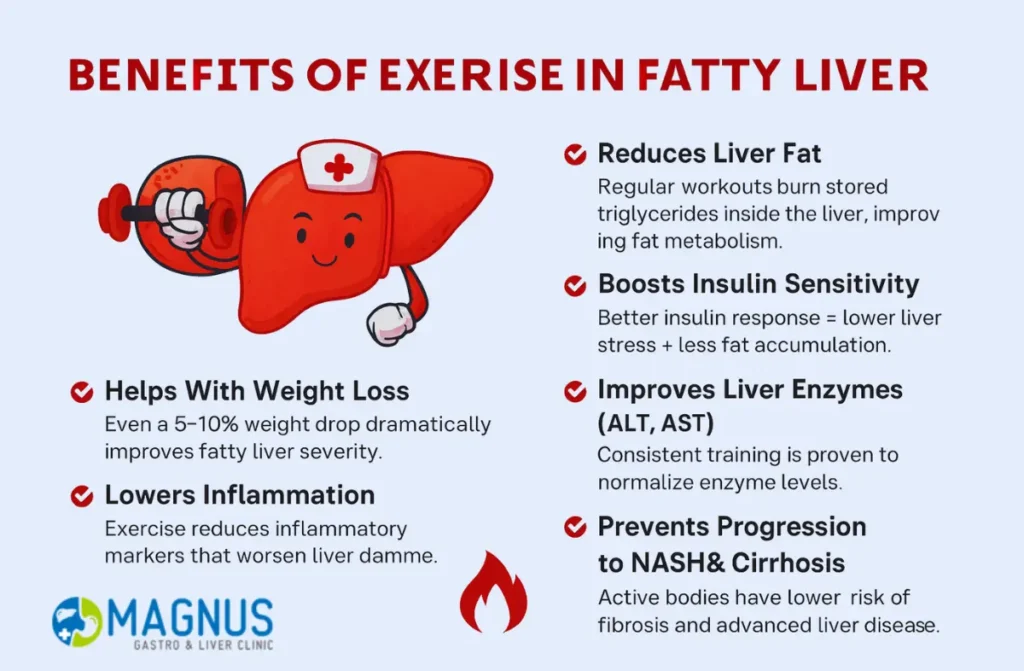Liver disease can significantly impact one’s health, but exercise can be a key component in managing and improving liver function. Whether it’s fatty liver disease, cirrhosis, or alcoholic liver disease, incorporating the best exercise for liver disease into your routine can help reduce symptoms and improve overall well-being. Understanding the best exercise to reduce fatty liver or the best exercise for liver disease is essential for anyone dealing with these conditions.
Regular physical activity aids in weight management, reduces inflammation, and improves blood circulation to the liver. In this blog post, we will explore the best types of exercise for liver disease, focusing on their benefits and how they can play a role in improving liver health. From liver exercise yoga to cardiovascular workouts, discover how tailored physical activity can support conditions like liver cirrhosis and alcoholic fatty liver. If you’re looking for ways to take control of your liver health, read on to find out more.
7 Best Exercises for Liver Disease
Walking
- The best exercise for liver disease begins with something simple: walking. It’s easy to start and doesn’t require any special equipment. Walking helps reduce fat in the liver, and it’s a great low-impact exercise for people with liver disease.
- Best exercise to reduce fatty liver: Walking helps manage weight, which can reduce liver fat.
- Best exercise for liver cirrhosis: If you have cirrhosis, start with light walking and gradually increase intensity.
Cycling
- Cycling is a cardiovascular workout that improves circulation and strengthens muscles, which can reduce liver fat. It’s also gentle on the joints and can be adjusted to your fitness level.
- Best workout for fatty liver: Cycling boosts metabolism, helping the liver function better.
Swimming
- Swimming is an excellent full-body exercise. It reduces fat and helps detoxify the liver. The water’s buoyancy reduces strain on your joints, making it ideal for people with liver disease.
- Best exercise for alcoholic fatty liver: Swimming helps to lower liver fat and improve heart health.
Yoga
- Yoga is a gentle exercise that can improve liver function by reducing stress and inflammation. Poses that focus on the core and abdominal area can help promote detoxification.
- Best exercise for liver disease: Yoga helps with overall liver health and reduces symptoms of liver disease. Liver exercise yoga is particularly beneficial for improving liver function and alleviating discomfort caused by liver conditions.
Strength Training
- Strength training with light weights or resistance bands helps build muscle mass and burns fat, supporting liver health. This type of exercise can also improve insulin sensitivity and reduce fat in the liver.
- Best exercise for liver cirrhosis Strength training should be done under supervision, especially if you have cirrhosis.
Tai Chi
- Tai Chi is a slow, deliberate form of exercise that helps improve balance, circulation, and relaxation. It’s particularly good for people with liver disease who need a low-impact routine.
- Best exercise for liver disease: Tai Chi reduces stress and improves liver detoxification.
Dancing
- Dancing is not only fun but also an effective workout. It improves cardiovascular health and helps burn calories, which can reduce fat in the liver.
- Best workout for fatty liver: Dancing is a great way to maintain a healthy liver by managing weight and improving circulation.

Liver Disease Patients Should Start With Walking
Walking is often recommended as the best exercise for alcoholic fatty liver or any form of liver disease. It’s gentle yet effective, allowing individuals to ease into a fitness routine. Here are some reasons why you should start with walking:
- Gentle Yet Effective: Walking is a low-impact activity that does not strain the liver or joints, making it the best exercise for liver disease. It improves circulation and metabolic function without overexerting the body, allowing patients to ease into physical activity safely.
- Reduces Liver Fat and Enhances Function: Consistent walking helps burn excess calories, reducing fat accumulation in the liver. Studies suggest that regular walking significantly improves liver enzyme levels, leading to better liver health over time.
- Minimizes the Risk of Exercise-Induced Liver Strain: Some high-intensity exercises can cause muscle breakdown, releasing toxins that burden the liver. Patients often ask, “Can exercise damage the liver?” While excessive strenuous workouts may, moderate exercises like walking support liver function without added stress.
- Supports Weight Management and Metabolism: Being overweight is a major risk factor for fatty liver disease. Walking regularly helps maintain a healthy weight, boosts metabolism, and reduces inflammation, all of which are crucial for liver health.
- Easily Accessible and Sustainable: Unlike specialized fitness programs, walking requires no equipment or membership. It can be done indoors or outdoors, making it an easy lifestyle change for long-term liver care.
- Complements Liver Exercise Yoga: Walking can be paired with liver exercise yoga to enhance flexibility, reduce stress, and improve liver detoxification. A balanced routine incorporating both helps maximize liver function and overall well-being.
Start with a short walk and gradually increase the duration and intensity. Walking consistently will improve your stamina and support liver health over time.
How Will Exercise Benefit Me?
| Aspect | Explanation |
| Reduces Liver Fat | The best exercise for liver disease like walking, cycling, or strength training lowers fat stored in the liver and improves liver function. |
| Improves Insulin Sensitivity | Exercise helps control blood sugar and reduces fat buildup in the liver, especially in people with metabolic conditions. |
| Enhances Liver Enzymes | Physical activity lowers elevated liver enzymes, a sign of reduced inflammation and better liver health. |
| Aids Weight Management | Losing even 5–10% of body weight through exercise significantly improves liver fat levels and reduces the risk of disease progression. |
What Do I Need to Consider Before Starting Exercise?
Before beginning an exercise routine, consider the following:
- Consult with Your Doctor: Before beginning any fitness routine, it is crucial to consult your healthcare provider, especially if you have liver disease. They can assess your condition and recommend the best exercise for liver disease that aligns with your health status, preventing potential complications.
- Start with Low-Intensity Movements: Engaging in gentle exercises such as walking, stretching, or liver exercise yoga can help improve circulation and boost liver function without putting excessive strain on your body. Gradually increasing intensity allows for better adaptation while avoiding unnecessary stress on the liver.
- Avoid High-Impact Workouts: Strenuous activities such as heavy weightlifting or prolonged high-intensity cardio can elevate stress levels and lead to inflammation, which might worsen liver conditions. Always opt for low-impact exercises like swimming, cycling, or light resistance training to stay active without risk.
- Can Exercise Damage the Liver?: While moderate exercise supports liver health, overtraining or excessive high-intensity workouts can lead to muscle breakdown, releasing harmful toxins that the liver must process. This additional burden may lead to oxidative stress and hinder recovery, making it essential to follow a balanced workout routine.
- Focus on Strength and Flexibility: Yoga and Pilates help improve flexibility, core strength, and circulation, benefiting liver function. Specific liver exercise yoga poses like the seated twist and bridge pose can stimulate digestion and detoxification, promoting better metabolic health.
It’s important to find exercises that suit your fitness level and don’t overstrain your body, especially when dealing with liver disease.
Physical Exercise Modality, Intensity, and Duration
Exercise supports liver health by reducing fat accumulation, improving insulin sensitivity, and enhancing liver enzyme function. Choosing the right type, intensity, and duration is essential for long-term benefits.
- Aerobic and Resistance Training: Aerobic activities like walking or cycling are considered the best exercise for liver disease as they lower liver fat. Resistance training builds muscle and boosts metabolism, aiding liver function.
- Moderate Intensity: Workouts at 60–70% of max heart rate are ideal. This level supports fat burning without straining the body.
- Optimal Duration: Aim for 150 minutes per week, with 30–45 minutes per session, spread over 4–5 days. Consistency is key.
- Combined Approach: A mix of aerobic exercise for fatty liver and resistance workouts is the best exercise for liver disease, offering better fat control and muscle strength.
The Mechanism of Physical Exercise in Protecting against Liver Diseases
Regular physical activity protects the liver by reducing fat accumulation, improving insulin sensitivity, and controlling inflammation. These effects slow the progression of conditions like fatty liver and support overall hepatic health.
- Improved Insulin Sensitivity: Exercise boosts glucose uptake and reduces insulin resistance. This prevents excess fat storage in liver cells, supporting Exercise for Healthy Liver.
- Reduction in Hepatic Fat: Aerobic workouts enhance fat oxidation and limit fat production in the liver. This is crucial for managing NAFLD effectively.
- Stress Reduction via Liver Exercise Yoga: Practices in liver exercise yoga help lower cortisol, which reduces liver inflammation. Poses like twists and backbends improve blood circulation to the liver.
- Long-Term Adaptation: Regular Exercise for Healthy Liver induces gene-level changes that improve fat metabolism. Adding liver exercise yoga offers both physical and emotional benefits.
Conclusion
The best exercise for liver disease includes activities like walking, swimming, and yoga, which can reduce liver fat and improve overall function. Whether you’re dealing with fatty liver, cirrhosis, or alcohol-induced liver damage, regular exercise is one of the most effective ways to manage symptoms and improve your liver health. Start with low-impact exercises and gradually increase the intensity.
Read Also: Testing For Viral Hepatitis




